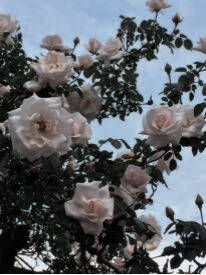
‘New Dawn’ rose is a climber that blooms in spring and then again in fall.
Photo courtesy of Paige Burns
ROCKINGHAM — Another Valentine’s Day has come and gone. Perhaps you received – or gave – roses in recognition of the day, as it is the go-to gift, along with a heart shaped box of chocolates, of course. Most roses purchased from a florist in the US were grown in South America, where they are grown in greenhouses across the country. Ecuador in particular is famous for its rose industry, being close to the equator at high altitudes, which provides the most sunlight needed to achieve long, sturdy stems. Greenhouses allow the roses to be grown at optimum temperatures and humidity, and intensely managed for insects and diseases.
While it is basically impossible to achieve florist quality roses in a home garden, if you love roses and would like try your hand at growing your own, you can still have lovely roses with some knowledge and care.
First, know your roses. Even a fairly casual gardener can be successful growing roses if planting the right selection. Types of roses are too numerous to list, but include tiny miniature bush roses for containers, to climbers that can ramble over an arbor, and bush types such as hybrid teas and floribundas. A beautiful harbinger of spring with its clusters of soft yellow flowers, the Lady Banks climbing rose is well known and loved in the South. ‘New Dawn’ is a climber that is a personal favorite, with large light pink flowers, lovely rose scent, that blooms in spring then lightly again in fall. Hybrid teas are the primary type grown as long stem roses. They are so called because the flower smells more like “tea” than the expected rose fragrance. These are for the more experienced rose grower, as they are more demanding. Hybrid teas are larger bush types, and may reach 4-6 feet tall. Floribundas are shorter bush roses, 3-4’, and some are somewhat disease resistant. The plant is a cross between hybrid teas and polyantha roses, with the result of more blooms along with the beautiful, classic rose flowers and colors characteristic of hybrid teas. Most people are familiar with Knockout Roses, which have made roses almost ubiquitous in home gardens and commercial landscapes. Knockouts are in the Modern Shrub Rose category, and came with the most hardiness and disease resistance of any rose, although unfortunately this is now in decline, due to overplanting.
Roses of whatever type need full sun for most of the day, especially in the morning. You’ll notice that serious rose gardeners often plant their prize roses in beds by themselves, which reduces competition from other plants and improves efficiency for typical tasks such as fertilizing, pruning, and pest management. When planting any type of rose, provide space with good air circulation to help prevent diseases, and amend the soil well with compost. Roses require soil loaded with organic matter, and have relatively high fertility needs. When planting, if bare root, spread the roots out evenly over a mounded center in a generously sized hole, being sure to keep the graft union, if present, above the soil line. If the rose is a container plant, keep the top of the root ball level with the surrounding soil grade, using care not to make the plant hole too deep nor too shallow.
Roses need a good amount of both water and fertilizer. Plenty of organic matter like compost mixed in with the native soil helps to hold both water and fertilizer around plant roots. When watering, avoid getting leaves wet which can result in disease. Soaker hoses that allow for deep, gentle watering is best. Be sure not to over-water: soil should be moist, but well drained, so that if you squeeze a handful of soil, the soil stays together but does not release free water. Fertilize roses with a slow release shrub fertilizer (following label instructions) as leaves begin to break in spring, fertilizing twice per year (the second no later than late August), or if a constant bloomer after each flush of flowers, again until late August. Keep soil covered with 2” of pine straw or pine bark mulch to suppress weeds and hold soil moisture.
Roses require extensive pruning to keep them healthy and maintain their shape. Typically, for a bush-type, cut back your roses by one-third in late winter just prior to bud break. Cut the stem down to just above (about ¼”) an outward facing bud. Remove crossing branches that rub against each other and branches with signs of disease, working to open the interior of the shrub to improve air circulation. Keep your pruners sharp, and sanitize them between plants with rubbing alcohol, or after each cut if stem has disease.
Common diseases on roses include black spot and powdery mildew, rose mosaic, a virus which causes mottling on leaves, and another virus called Rose Rosette which is a particular problem on Knockout roses. Insect pests include Japanese Beetle, thrips (which damage the flowers), and aphids.
If you’d like more information about caring for roses, contact us at NC Cooperative Extension, Richmond County Center. Check out our website and follow us on Facebook.
